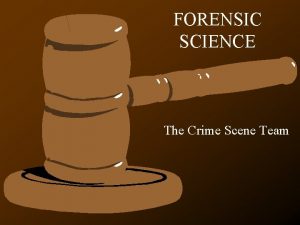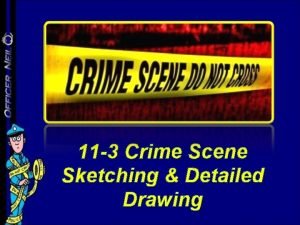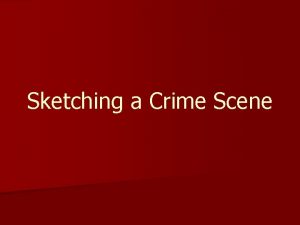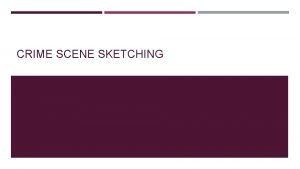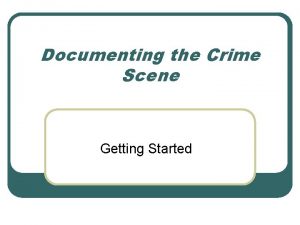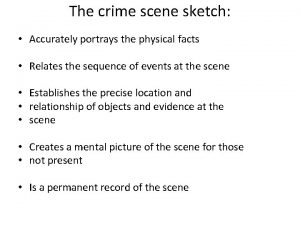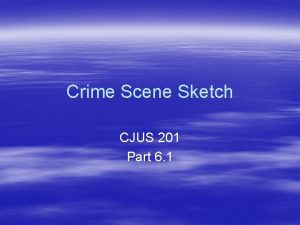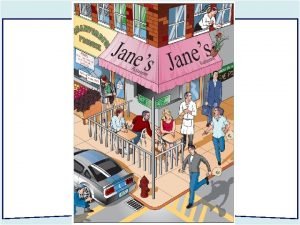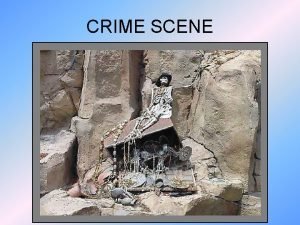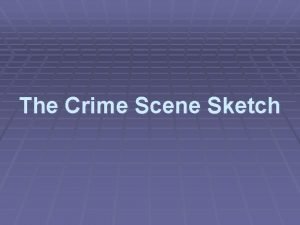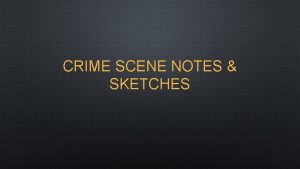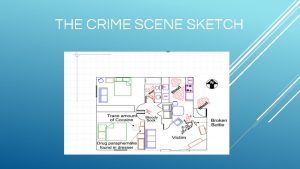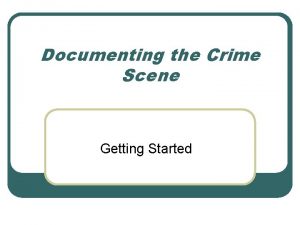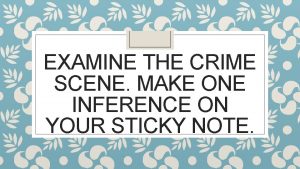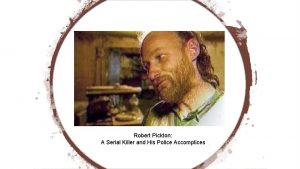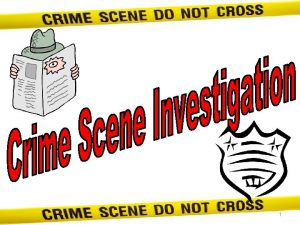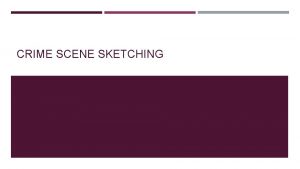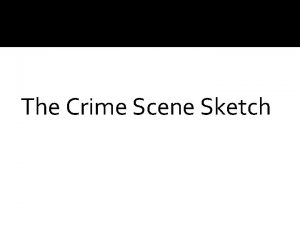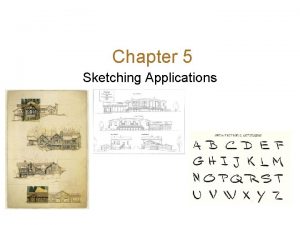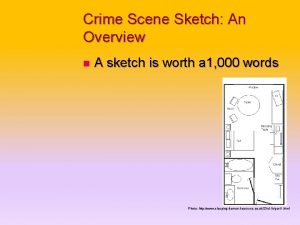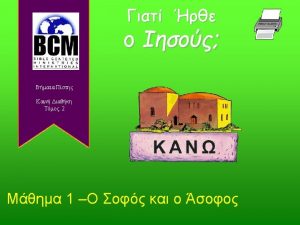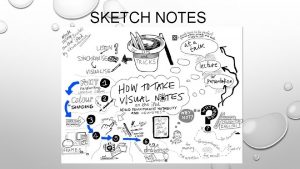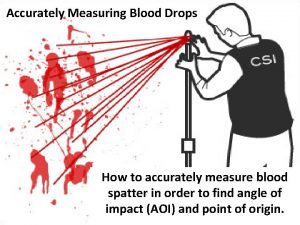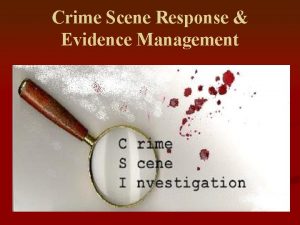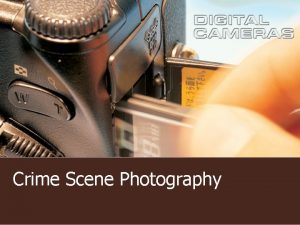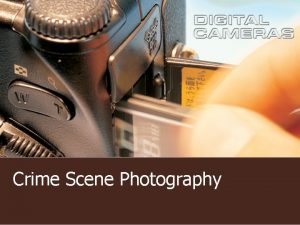CRIME SCENE SKETCHING THE CRIME SCENE SKETCH Accurately

















- Slides: 17

CRIME SCENE SKETCHING

THE CRIME SCENE SKETCH Accurately portrays the physical facts Relates the sequence of events at the scene Establishes the precise location and relationship of objects and evidence at the scene Creates a mental picture of the scene for those not present Is a permanent record of the scene

OVERVIEW A crime scene sketch assists in: 1) Interviewing and interrogating persons 2) Preparing an investigative report 3) Presenting the case in court The sketch supplements photographs, notes, plaster casts and other investigative techniques. Two types of sketches 1. Rough sketch 2. Finished or scale sketch

ROUGH SKETCH The rough sketch is the first pencil-drawn outline of the scene and the location of objects and evidence within this outline. Usually not drawn to scale Although distances are measured and indicated in the sketch Sketch after photographs are taken and before anything is moved. Sketch as much as possible.

TYPICAL MATERIALS Paper (usually graph) Clipboard Pencil Eraser Measuring tape Ruler

STEPS 1. Observe and plan 2. Measure distances Steel tape is best (doesn’t stretch) Use conventional units of measurement (inches, feet, centimeters, meters) Measure from fixed locations (walls, trees, corners, other immovable objects) Determine the scale Take the longest measurement at the scene and divide it by the longest measurement of the paper used for sketching. ½”= 1’small rooms ¼”= 1’large rooms 1/8”= 1’very large rooms

STEPS 3. Outline the area North should be at the top of the paper 4. Locate & Plot objects and evidence within the outline Plotting methods are used to locate objects and evidence on the sketch. They include the use of: Rectangular coordinates (the one we will use most often) A baseline Triangulation Compass points.

PLOTTING METHODS Rectangular Coordinates Uses two adjacent walls as fixed points as distances are measured at right angles Baseline Method Run a baseline from one fixed point to another, from which measurements are taken at right angles.

PLOTTING METHODS Triangulation Common in outdoor scenes Uses straight-line measurements from two fixed objects to the evidence to create a triangle with evidence in the angle formed by two straight lines. Compass Point Method Uses a protractor to measure the angle formed by two lines

PLOTTING METHODS Cross-Projection Presents floors and walls as they were on one surface

STEPS 5. Record details Examples: Room dimensions Distances between objects Types of objects in room Evidence locations Measure more than you need!

STEPS 6. Identify the sketch with a legend a scale • Examples: • Persons assisting • Direction of North • Identifying information in sketch -Key • Scale • Case Number: date and case of the day. Ex. Sept 20, 2019 case 5 of the day = 09201905


CRIME SCENE SKETCH Date: August 14, 2005 Criminalist: Ann Wilson Time: 11: 35 am Location: 4358 Rockledge Dr. , St. Louis, Mo. N 5 ft 14

FINAL SKETCH Finished sketch COMPLETED AFTER SCENE PROCESSED! • Looks prettier: to scale, etc. • Drawn by skilled individual (ex: artist) • May be done on computer

FINAL SKETCH REQUIRES 1. To scale – use ruler! 6. Name of sketch artist 2. Scale labeled ex: ¼” = 1’ 7. Investigators assisting 8. Location 3. Compass North is labeled 4. Suspected type of Crime 5. Date of sketch 9. Case number 10. Legend with evidence labeled 11. Color

CRIME SCENE SKETCH
 Crime scence investigator
Crime scence investigator Disadvantages of freehand sketching
Disadvantages of freehand sketching Rough crime scene sketch
Rough crime scene sketch What should a crime scene sketch include
What should a crime scene sketch include Sketch of locality in crime scene
Sketch of locality in crime scene What must be included on a crime scene sketch
What must be included on a crime scene sketch Cross-projection sketch
Cross-projection sketch Druggist fold definition
Druggist fold definition Crime scene
Crime scene Can a crime scene sketch have probative value
Can a crime scene sketch have probative value Legend crime scene sketch
Legend crime scene sketch Crime scene notes
Crime scene notes Method of sketching
Method of sketching Sketch all serious crime and crash scenes
Sketch all serious crime and crash scenes Crime scene inference
Crime scene inference Robert pickton trailer
Robert pickton trailer Phil spector crime scene
Phil spector crime scene The term encompasses all objects that can establish
The term encompasses all objects that can establish
